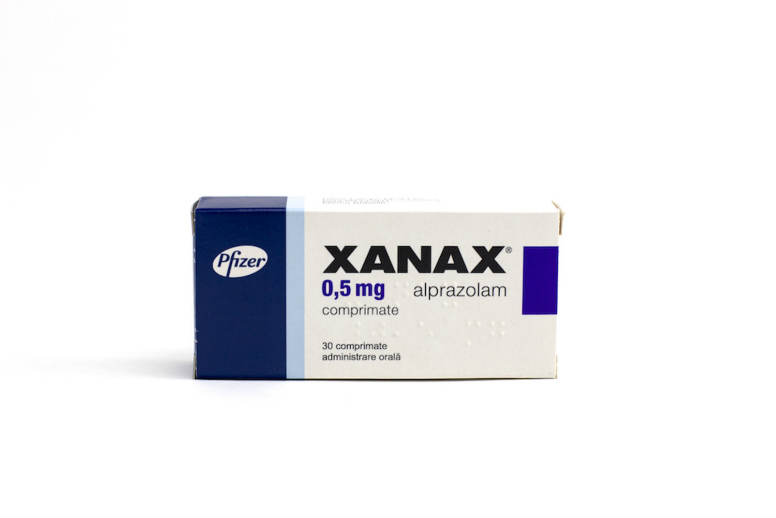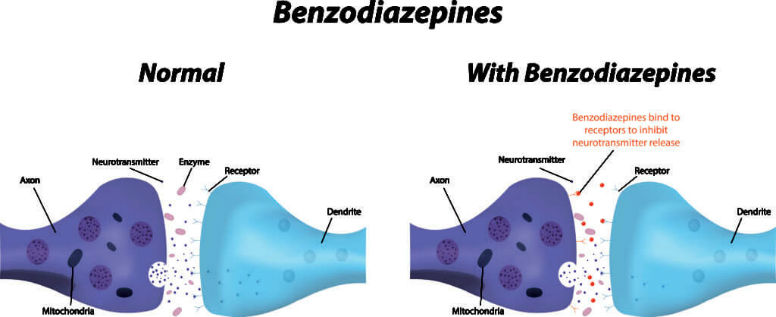The Complete Guide to Xanax
Table of Contents
- The Complete Guide to Xanax
- What is Xanax?
- What Is a Xanax Bar?
- Is Xanax Addictive?
- The Many Colors and Varieties of Xanax
- Common Slang for Xanax Pills
- The Extreme Risks of Counterfeit Xanax
- The Relationship Between GABA and Xanax
- What are the Dangers of Abusing Xanax?
- Xanax Tolerance vs Dependence vs Addiction
- How Long Does It Take to Get Addicted to Xanax?
- What are the Signs Of Xanax Addiction?
- Can You Overdose from Xanax?
- The Dangers of Cold Turkey Benzo Detox
- Medically Supervised Detox for Xanax Bars
- Why is Xanax Addictive?
- How Addictive is Xanax?
- Xanax Abuse Statistics
- Treatment of Xanax Addiction
- Choosing the Right Xanax Addiction Rehab Program For Your Needs
- Find Effective Xanax Treatment Options Nationwide: Call Now!
Xanax is associated with American pop culture. Rappers regularly rap about it, and in sitcoms, there is always the offbeat stressed father or mother saying they need one to chill. However, Xanax is essentially just a brand name.
The real drug’s name is alprazolam. In 2010, alprazolam was the 12th most prescribed drug in the US and it is among the most popular category of benzodiazepine. As a result, Xanax addiction is all too common in our country.
It was developed in the 1960s as a sleep aid but it was found to be effective in treating anxiety, mood, and panic disorder. Therefore, it was subsequently prescribed for these conditions. Due to its extreme popularity, as well as high susceptibility to misuse, we offer our complete guide to Xanax bars for anyone who needs to know more.
Xanax is relatively safe when used as prescribed. However, it is often abused by people who are self-medicating as well as recreational users who simply want to get high.
It is classified as a Schedule IV substance by the Drug Enforcement Agency (DEA), meaning it has a recognized medical use, but it also has the potential for addiction and abuse. Therefore, doctors often prescribe Xanax for as short a period as possible and they closely monitor the patient. Negative side effects are more likely when a person misuses Xanax.
However, whether you’ve been prescribed Xanax or you’ve been sourcing it illegally, you need to seek help if you’re finding it hard to control your usage. With professional treatment, you can overcome your addiction and develop healthier practices. Let’s take an in-depth look at Xanax bars and how using them can lead to dependence and addiction.
What is Xanax?

Xanax is a short- to moderate-acting benzodiazepine. It is an anti-anxiety drug in the benzos family, the same class that includes Dalmane (flurazepam), Ativan (lorazepam), Valium (diazepam), Klonopin (clonazepam), and other drugs. The Center for Substance Abuse Research (CSAR) reports that there are at least 15 kinds of benzodiazepines in the US today. These drugs are used to assist patients to deal with anxiety problems and have been listed as Schedule IV drugs since they are less likely to be abused.
Xanax works by decreasing anomalous excitement in the brain and is approved by the Food and Drug Administration (FDA) to treat panic disorders. It comes in various colors and shapes and is mainly used to deal with moderate to severe panic attacks and anxiety. The drug is also used to treat anxiety that originates from moderate depression. The drug can also help in easing sleeping disorders.
Alprazolam comes in extended-release and immediate-release formats. These tablets come in 0.5 to 3 milligrams strength. The drug is also known by a number of other street names including Z-Bars, Bars, Handlebars, Zanbars, Xannies, Blue footballs, Bricks, Benzos, School Bus, Upjohn, White girls, White boys, Yellow boys, and Bicycle parts.
What Is a Xanax Bar?

On the street, you may hear people talking about Xanax bars. That’s because the highest dose of Xanax – 2 milligrams – comes in the form of rectangular tablets. These tablets are scored so they can be broken into halves or quarters. Typically, people who have been prescribed Xanax for anxiety take 0.5mg or 1 mg. Individuals who buy Xanax illegally like the bars because they are more cost-effective than lower doses.
Is Xanax Addictive?
Patients can become addicted to Xanax even when they get prescriptions from doctors. This drug addiction risk increases when it is abused, taken without prescriptions, or taken for recreational purposes. A person is highly likely to become addicted to this drug (and do so quickly) if they take it more regularly or in larger dosage than prescribed. Additionally, the risk of addiction increases if an individual self-medicates the drug for mental health problem treatments.
Xanax addiction is not just about how often or how much a person takes. There are other risk factors that are involved such as biological and genetic underpinnings. The National Institute on Drug Abuse (NIDA) states that a person’s gene accounts for about ½ of the individual’s risk for Xanax addiction.
Therefore, a person will become addicted to this drug more quickly than any other individual if they have a family member who abuses the drug. Biology also plays a critical role in Xanax addiction development. Physical and mental health are the other factors that are believed to lead to its addiction.
The Many Colors and Varieties of Xanax
The appearance of Xanax depends on the dosage. While the 2mg tablet is white, the 1mg is blue with an elliptical shape and the 0.5mg is orange with an elliptical shape. The 0.25mg also has an elliptical shape, but it’s white. People also refer to generic 2mg alprazolam tablets as Xanax bars and these come in a variety of colors including blue, white, green, or yellow.
Common Slang for Xanax Pills
There has been an increase in the abuse of Xanax by young millennials and members of Generation Z. Popular rappers include terms like “Popping a Xan” in their songs and it is believed that this has helped to drive the increase. Common street names for Xanax include handlebars, totem poles, zannies, xanbars, planks, footballs, and xans.
The Extreme Risks of Counterfeit Xanax
One of the dangers of purchasing Xanax on the street is the possibility of getting counterfeit pills. Counterfeit Xanax may look just like the real thing. Not only can they be the same shape, size, and color as authentic pills, but they may have the same pharmaceutical imprint.
People who manufacture illicit drugs are always looking for ways to make the product cheaper and stronger so they can make more money. Therefore, counterfeit drugs can contain a variety of additives and toxins that make them more dangerous than the real thing. Fake drugs can include bleach, rat poison, formaldehyde, and other substances.
Despite their appearance, fake Xanax pills often contain fentanyl which is an extremely strong opioid. People who accidentally take fentanyl are at risk of an opioid overdose. Even if a person knows that their Xanax contains fentanyl, they won’t know how much or how strong it is.
It is often impossible to know whether Xanax pills purchased on the street are real or fake. However, if the pill is laced with fentanyl, users may experience side effects that they otherwise wouldn’t.
Side effects of fentanyl use include:
- Flushed skin
- Nausea and vomiting
- Excessive itching
- Slowed breathing
- Constricted pupils
The Relationship Between GABA and Xanax
You may be wondering why people misuse Xanax. It has a lot to do with gamma-Aminobutyric acid or GABA. This is a neurotransmitter that keeps us calm, relaxes the muscles, and helps us to sleep.
Alprazolam imitates the action of GABA and this is why it induces relaxation. Within as little as 15 minutes, it can reduce heart rate, blood pressure, and body temperature. However, when it is used for a long period, the brain decreases its natural production of GABA.
What are the Dangers of Abusing Xanax?
As with many other medications, negative side effects can occur even when Xanax is used exactly as prescribed. However, these effects are more likely when this drug is abused. People who abuse Xanax often swallow the pills or place them under the tongue and let them dissolve. When you take Xanax orally or sublingually, the body gets the largest amount of the drug.
While some people snort or inject Xanax bars, these methods are less effective and therefore, less popular. In order to snort Xanax, individuals have to crush the tablets into a powder. When inhaled, Xanax irritates the delicate tissues in the nose and this can result in nosebleeds. With continued use, a hole may develop in the septum.
Meanwhile, Xanax bars don’t dissolve in water so it’s hard to inject alprazolam. The tablets can be dissolved in propylene glycol but this solution may cause pain when injected. Injecting Xanax can also result in skin infections and the contraction of hepatitis C and HIV.
Other side effects of abusing Xanax bars may include:
- Fatigue
- Nausea
- Mood swings
- Sleepwalking
- Memory loss
- Lack of balance and coordination
- Depression
- Slurred speech
- Changes in sex drive
- Changes in appetite
- Constipation
- Seizures
In addition to all these side effects, there’s also the risk of addiction.
Xanax Tolerance vs Dependence vs Addiction
People often don’t think about the link between tolerance and prescription drug usage. They assume that a drug is safe because it was prescribed by a doctor and it relieves their symptoms.
However, users of Xanax can develop a tolerance if they use it regularly. This means they need more and more of the drug to get the effects they did the first time.
If a person takes Xanax in a way that’s not prescribed, they can become physically dependent on it. This means their body needs Xanax to function properly and they’ll experience uncomfortable withdrawal symptoms if they stop taking it.
Addiction usually occurs along with physical dependence. The brain starts to depend on Xanax to produce GABA and the individual, therefore, experiences anxiety and depression if they stop using the drug. Usually, this leads them to take more Xanax so they can get relief. This perpetuates a cycle of addiction.
Anyone can develop a substance addiction especially when prescription drugs are involved. Therefore, people from socioeconomic backgrounds and professions can become addicted to Xanax.
Xanax vs Klonopin: Which One is Safer?
Klonopin or clonazepam, like Xanax, is a benzodiazepine that reduces stress and improves sleep. However, it is more addictive than Xanax and is, therefore, usually only prescribed for short-term use. Klonopin produces a greater feeling of euphoria and the more the brain experiences this, the more it wants. Individuals, therefore, experience the urge to use Klonopin time and time again.
Klonopin can result in the development of tolerance faster than Xanax. Since the effects of the drug wear off quickly, users are inclined to increase the dosage so they can continue experiencing euphoria. With continued use, dependency may develop.
Xanax vs Valium: What’s the Difference?
Valium or diazepam is another benzodiazepine that is used to treat panic attacks, anxiety disorders, and seizures. It can also be used to treat symptoms associated with alcohol withdrawal. Valium can be highly addictive, especially if it is used recreationally or taken for several weeks at a time.
Unlike Xanax, Valium is a long-acting benzodiazepine. Since it stays in the body longer, users usually need fewer doses per day. However, some people still misuse it because of its calming effects.
How Long Does It Take to Get Addicted to Xanax?
Some people become addicted to Xanax faster than others, still, people who take large doses regularly are more likely to become addicted than those who take low doses infrequently.
Taking Xanax for longer than three to four weeks can lead to dependence. This is why doctors often prescribe only a one- to two-week supply. Dependence becomes an addiction when the individual experiences negative consequences as a result of their drug use but continues using anyway.
What are the Signs Of Xanax Addiction?

People who are addicted to Xanax face a wide range of mental, physical, and social consequences. Obtaining and using the drug becomes more important than anything else and they need professional help to overcome their addiction. Signs that a person may be addicted to Xanax include:
- Using more than the prescribed dosage
- Having Xanax pills not prescribed to them
- Stealing Xanax from other people
- Stealing money from people to buy Xanax
- Trying to quit or reduce their usage but failing to do so
- Getting multiple prescriptions from multiple doctors
- Missing social, professional, or familial obligations
Other indicators include:
- Constant fatigue or sedation
- Changes in behavior
- Strained relationships
- Lack of interest in usual hobbies
If you notice these signs in a loved one, you’ll naturally be concerned. It’s a good idea to contact an addiction treatment center for advice on how to proceed.
Can You Overdose from Xanax?
Abusing Xanax bars can lead to overdose but this risk is relatively low. The risk is higher if Xanax is combined with other central nervous system depressants such as alcohol, opioids, or other benzodiazepines.
A 2015 study in the American Journal of Preventive Medicine found that about two-thirds of fatal benzodiazepine overdoses also involved opioids. The central nervous system can slow down so much that it causes extreme sedation and significantly depressed breathing leading to coma or death.
Meanwhile, combining Xanax bars with central nervous system stimulants such as amphetamine and cocaine also increases the risk of overdose. People often combine stimulant and depressant drugs in the hopes that they will balance out each other.
However, the combination of relaxation and euphoria can cause people to think they need more of one of the drugs since the effects don’t seem strong enough.
Signs of Xanax overdose include:
- Fatigue
- Unconsciousness
- Disorientation
- Weakness
- Floppiness
- Confusion
- Shallow breathing
- Blue lips or nails
The Dangers of Cold Turkey Benzo Detox
It is not recommended that individuals stop taking Xanax or other benzos abruptly. Addiction is harmful but suddenly quitting is also problematic. That’s because it can lead to life-threatening withdrawal symptoms and lasting damage to the central nervous system. The central nervous system takes a long time to heal after benzodiazepine withdrawal.
In some cases, it takes between 6 and 18 months for people to fully recover. If symptoms last for more than 18 months, this is considered a protracted withdrawal and it can last for years. Therefore, it’s important to avoid a sudden cessation of Xanax use.
When the brain is suddenly deprived of benzos, GABA levels drop and the nervous system goes into a state of hyperexcitability. This leads to most of the withdrawal symptoms individuals experience.
A person who withdraws cold turkey from long-term benzos use typically experiences uncomfortable and sometimes dangerous side effects. These include:
- Akathisia (an inability to stay still)
- Inability to concentrate
- Irritability
- Headaches
- Sleep disturbances
- Trembling
- Anxiety and/or panic attacks
- Palpitations
- Muscle pain and stiffness
Severe benzodiazepine withdrawal symptoms are similar to those of acute alcohol withdrawal and they include:
- Psychosis
- Seizures
- Catatonia
- Delirium tremens
- Hallucinations
- Suicide
This is especially likely if an individual was taking high doses of benzos. However, seizures don’t usually occur when people slowly taper off their dosage unless they were taking benzodiazepines for a seizure disorder. Similarly, psychosis is rare in individuals who follow a tapering schedule.
Misconceptions About Cold Turkey Withdrawal
Some people believe that withdrawal symptoms go away faster when a person quits cold turkey. This is in keeping with a view that slowly tapering off your dosage prolongs the discomfort.
However, cold turkey withdrawal may actually result in a longer course of withdrawal syndrome and it may increase the risk of protracted withdrawal.
If you or someone you love is addicted to Xanax, you need to talk to an addiction treatment professional about the safest way to stop using this drug. By reducing the dosage slowly, the body can adjust gradually. This needs to be done under medical supervision.
Medically Supervised Detox for Xanax Bars

Before Xanax addiction can be treated, individuals need to undergo detoxification. You should never attempt to do this on your own. Since withdrawal symptoms can be life-threatening, people who are detoxing need to be monitored around the clock by medical professionals.
A person undergoing withdrawal benefits from medications that can control the symptoms and if an emergency situation arises, they’re able to get prompt care. Medically supervised detox helps to ensure that people seeking to overcome Xanax addiction are as safe and comfortable as possible.
Xanax Bars Withdrawal Timeline
Each person will have a unique experience when they go through withdrawal. However, the process tends to follow a particular timeline.
Within 6 to 12 hours, most users of short-acting benzodiazepines such as Xanax start to experience withdrawal symptoms. These symptoms can include anxiety, Xanax cravings, and insomnia. These symptoms will worsen as the detox process continues.
Between days one to five, individuals may experience anxiety, panic, nausea, headaches, and profuse sweating. Insomnia, irritability and mood swings also present challenges during this time and some people become violent. Some individuals are also at risk of seizures, hallucinations, or psychosis. These symptoms usually reach their peak after the first four to five days.
People who have been prescribed Xanax for the treatment of insomnia, general anxiety disorder, or panic disorder may also experience rebound symptoms in the first one to three days. Their insomnia and anxiety may be worse than it was before.
Over days 5 to 15, withdrawal symptoms plateau and then start to dissipate. In most patients, the majority of the symptoms go away within two weeks. However, some people experience a form of protracted withdrawal known as Post-Acute Withdrawal Symptoms (PAWS).
Symptoms can last for months after the final dose of Xanax. Post-acute symptoms are most likely to occur in people who have an extended history of drug use, particularly those who take large doses and are very heavily dependent.
Why is Xanax Addictive?
Alprazolam receives and releases a heightened amount of dopamine – a neurotransmitter chemical that controls the pleasure and reward center in the brain – while reducing the amount of gamma-aminobutyric acid (GABA), a class of receptors that receives dopamine, in the brain. Consuming the drug, therefore, means that there is excess dopamine in the brain due to increased production. The brain receives the excess dopamine, decreasing the feeling of anxiety, panic, and other negative states while increasing the reward and pleasure feelings.
The increase in dopamine might lead to a euphoric experience for some users, and that feeling is what users seek out when they abuse the prescription pill. Alprazolam is regularly prescribed for generalized panic disorder and anxiety, a theory that can help to explain the high rate of Xanax addiction. Patients with anxiety are at a higher risk of getting addicted to Xanax than the general public because it is convenient for them to depend on prescription medicine to ease their problems.

(Xanax Effect On The Brain)
How Addictive is Xanax?
Xanax owes its highly addictive nature to its qualities as a high-potency benzodiazepine with a short half-life. This is why it is regularly preferred for its intermittent use. And it is also what makes the substance attractive to drug users. When abused, it forms dependence fast, resulting in a severe addiction.
Xanax Abuse Statistics
Xanax abuse statistics can only be understood by looking at previous addiction treatment. Admissions to rehab centers have increased by 79% since 2002 because of benzodiazepine abuse. Xanax, the number one abused benzo, contributes the highest percentage of this number. Different doctors administered about 30 million alprazolam prescriptions in 2002. By 2007, this figure had increased by 7.5 million. That means that its prescription increased by about 1.25 million every year.
Sadly, as these prescriptions increased, so did Xanax overdoses. Between 2004-2008, alprazolam addiction contributed to an 89% increase in emergency room (ER) visits. There were about 65,000 ER visits for this drug in 2006. In 2010, this number stood at 125,000. These statistics show how prescriptions lead to addiction when abused, misused, or combined with other drugs or alcohol.

Treatment of Xanax Addiction
Detox is important but it’s just the first step in treating a Xanax addiction. After the body has rid itself of the drug, individuals need to address the psychological aspects of addiction and learn how to stay away from addictive substances. This is done in a rehabilitation program.
Cognitive-behavioral therapy has been shown to be highly effective. It helps individuals to understand how their thought and behavioral patterns led to their Xanax abuse and addiction.
They work closely with their therapist to come up with healthier ways of coping with the issues that led to their addiction. They also learn how to manage triggers and cravings in the long term.
CBT can also help to address co-occurring disorders. Some people have other mental health disorders in addition to their substance addiction and these need to be addressed at the same time. Other interventions include contingency management, motivational interviewing, and group therapy.
As rehab nears its end, patients get assistance with aftercare planning. Aftercare can include 12-step meetings, individual counseling, and group therapy. A good aftercare plan helps to prevent relapse and ensure long-term recovery.
Choosing the Right Xanax Addiction Rehab Program For Your Needs
If your Xanax use is out of control, you should talk to a professional. Whether you’re misusing prescribed Xanax or sourcing alprazolam on the streets, you shouldn’t try to quit on your own. Physicians and addiction treatment professionals are there to help you, not judge you so you don’t need to be ashamed of seeking assistance. Untreated addiction only gets worse so the sooner you seek treatment, the more likely it is that you will have a positive outcome.
However, it’s never too late to begin the process of recovering. There are lots of treatment facilities and programs around the country so you need to choose the right one for your needs.
Some people need to enroll in an inpatient treatment program while others would benefit from less intensive care. You also need to consider the quality of the various facilities and programs. Don’t be afraid to inquire about the facility’s success rates or the qualifications of the staff.
Insurance coverage is also a major consideration for many people who need substance abuse treatment. Most plans cover some form of addiction treatment but the out-of-pocket costs will vary.
When you’re looking into your options, you should contact your insurance provider and find out which services are included under your policy. You should also make sure you’re clear on co-pays and deductibles.
Find Effective Xanax Treatment Options Nationwide: Call Now!
Choosing a rehab facility can be difficult if you’re trying to do it on your own. However, Find Addiction Rehabs is here to help. We assist individuals struggling with addiction and their families in finding the treatment centers that best suit their needs.
Our representatives provide a wide selection of facilities that offer a full continuum of care including detox, residential programs, partial hospitalization programs, intensive outpatient programs, and regular outpatient programs. Therefore, we’re well equipped to help you get started on the path toward recovery.
Don’t delay in reaching out to get the help you need. We are ready to help, and only a phone call away!
Nicole R. is an experienced and accomplished writer with special interests in the fields of Anthropology, English, and behavioral health, and has written countless articles for newspaper publications, institutional research journals, and Find Addiction Rehabs.
Her alma matter is Florida Atlantic University in Boca Raton. Nicole hopes to spread awareness of and combat the stigmatization surrounding addiction and substance abuse treatment through her writing and work in the field.


